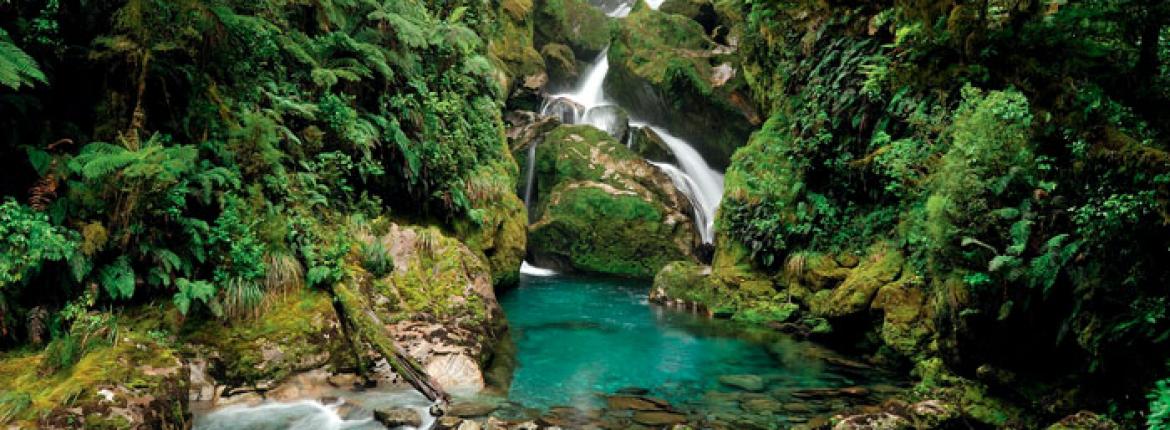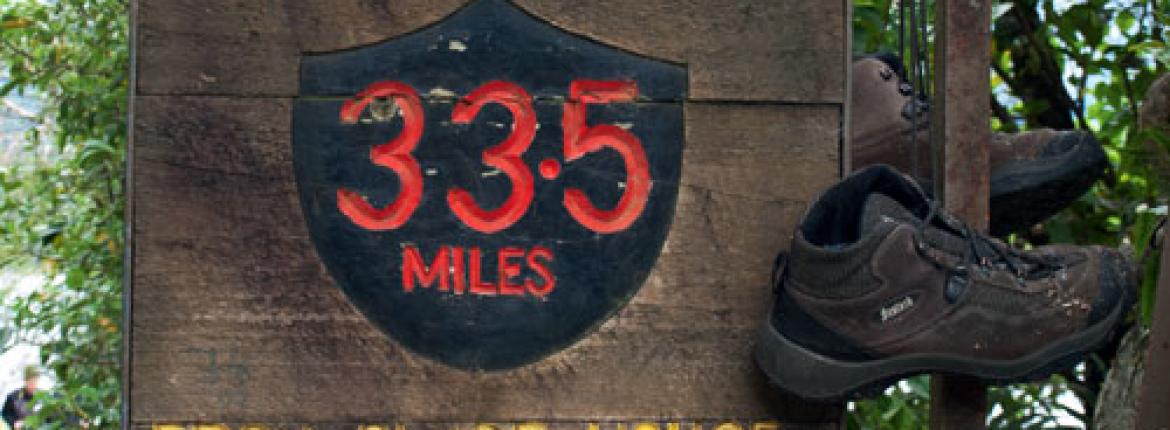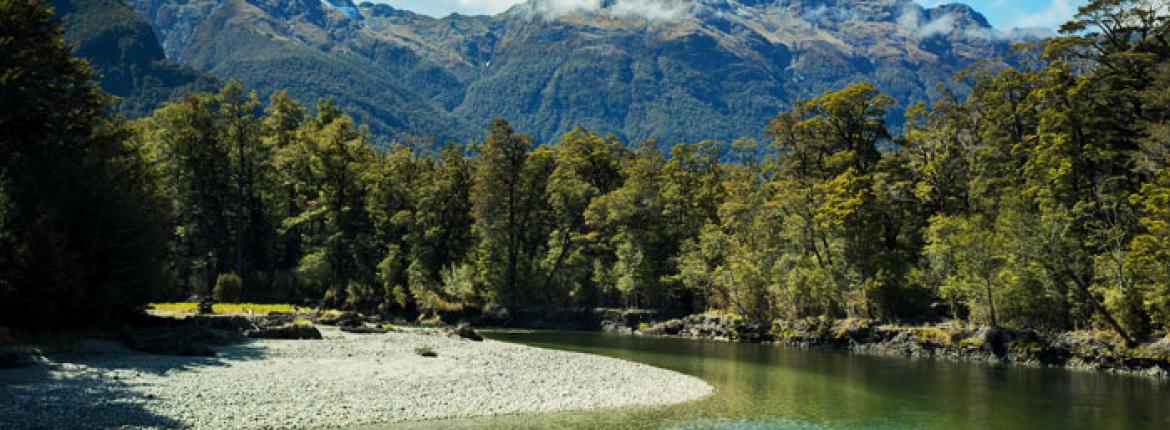Long smiles make for short miles’, reads the sign in Clinton Hut. “Changed around, it can work the other way, Mum,” observes my 10-year-old daughter, knowingly.
She is speaking from experience, having taken a brief but intense dislike to her backpack a few hours earlier – resulting in a long mile/short smile scenario. To be fair, we’d covered many miles by bus, boat and boot since our alarm woke us very early in Queenstown, so tiredness and over-excitement had a part to play in the meltdown.
But we’ve made it! Clinton Hut signals the end of day one of the Milford Track, a four-day, 53.5km walk from the head of Lake Te Anau to Milford Sound.
We are here to celebrate Rosie Bea’s 10th birthday. It seems a fitting way to mark the milestone, especially as DOC recommends that trampers be aged 10 and over to undertake the walk ‘due to the exposed mountainous environment and often adverse weather conditions’.
The weather is far from adverse the day we disembark from the ferry at Glade Wharf, scree-and-snow-capped mountains dwarfing us in every direction. As the ferry disappears around the bend, peace settles on the lake’s edge and we are enveloped in the feeling of remoteness and timelessness.
The first of many "Wows" is uttered a short time later when we emerge from a grove of beech trees dripping with lichen and spy the Clinton River, brilliantly clear and awash with glacial blues and greens. No wonder the Milford Track is popular.
During our four days on the track we share stories with visitors from all over the world, including a firefighter from Oregon who warns us he snores "like a big old grizzly bear", a 23-year-old ex-army cadet from Brisbane, a quiet card-playing couple from Spain, university students from Sydney, a family from Boston, two Australian women on holiday from kids and a young German couple. Many of them have come to New Zealand specifically to walk the Milford Track.
A dozen or so Kiwis disembark with us, too, but in many ways the Milford Track is New Zealand’s best-kept secret from itself. A lot of seasoned trampers haven’t walked it, perhaps thinking it will be too touristy, too tame, too controlled.
But a maximum of 40 independent (non-guided) trampers per day start from Glade Wharf to walk the track in a northerly direction. While we cover the miles in our own small group, an unexpected highlight is getting to know our fellow trampers at the end of each day.
The downside of hut-sharing is the snoring, sleep-talking, zizzing of zips, coughing and rustling – though Rosie Bea is so weary she sleeps through it all and awakes fresh, ready to tackle a bowl of porridge and the day ahead.
The second day is a gradual uphill climb to Mintaro Hut, which sits at around 600m. In response to the higher altitude, the vegetation and temperature change and we spy our first alpine flower – a bonus of walking the track in spring. Our young pace-setter is at her speediest across the rocky ‘no stopping zones’, aware that avalanches aren’t uncommon at this time of year.
Although maintained to an extremely high standard, the track is stony and hard underfoot and day two is trial by fire for our feet. We pull off our boots with sighs of relief when we reach the hut 16.5km later.
Each evening we are treated to a nature/local history talk by the rangers stationed at the huts, who also brief us on what lies ahead. We had pinpointed day three, up and over MacKinnon Pass, as the toughest – but Ranger Ed assures us it is manageable. Eleven zig-zags or ‘six zigs and five zags’ will see us to the top, he says.
The climb turns out to be a delight. Emerging from the treeline about halfway up, we enter an alpine wonderland of Mount Cook lilies, mountain daisies and other high-altitude plants which we weave our way through along a stony path reminiscent of a Japanese garden.
Up on MacKinnon Pass the weather is clear enough to see down the valleys, but misty and moody enough to remind us we are in Fiordland.
On go the layers, out come the cameras and, after a quick snack of scroggin sheltering behind the memorial cairn, we follow the path down between lily-ringed tarns to the MacKinnon Pass shelter. The shelter is divided in two. One side is for independent walkers like us; the other for guided walkers who pay for the knowledge of a guide and luxuries, such as hot showers, cooked meals, bed linen and warm drinks en route. Until 1966, the only option was to pay to walk the track guided, but a protest led by the Otago Tramping Club in Easter 1965 paved the way for ‘freedom walkers’.
As we settle into our bunks at Dumpling Hut later that night, the gang of 30 or so kea we’d spotted in the trees start up with their shriek-boom cries and continue on and off through the night. It is easy to imagine a noisy primordial forest teeming with moa, kakapo, kea and takahe and, for the first time, I have a real sense of what New Zealand has lost, species and habitat-wise.
The next morning, Rosie Bea’s sleepy face peers over the edge of the bunk above me. “I feel sad we have to say goodbye to the Milford Track today,” she says. We still have a way to go though and, at 18km long, day four proves to be the toughest, even though it is flat all the way from Dumpling Hut to the track’s end.
Rain falls lightly and steadily as Rosie Bea sets a cracking pace, fearful we’ll miss the 2pm ferry. The walk along the Arthur Valley is full of sights, including the thunderous MacKay Falls and Bell Rock, which we climb into with our head torches and, further on, the Giant Gate Falls, which we admire from yet another swing bridge. The last mile turns out to be the longest – and the smiles the shortest – but we reach Sandfly Point and the end of Milford Track with 20 minutes to spare.
Rosie Bea’s godmother and partner, who have walked with us, have a birthday surprise waiting when we reach Milford Sound – a flight back to Queenstown. We fly along the Arthur Valley, over MacKinnon Pass and part way along the Clinton Valley before turning toward Queenstown – with wide smiles and memories that will last a lifetime.
Reported by Sara Carbery for our AA Directions Summer 2013 issue






